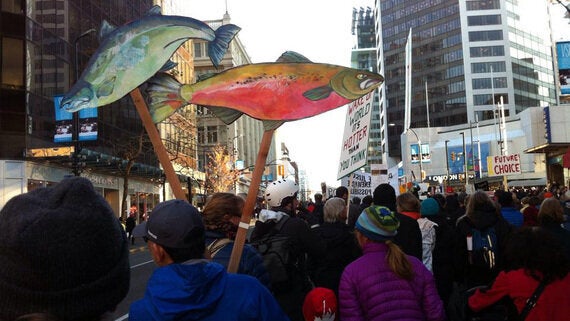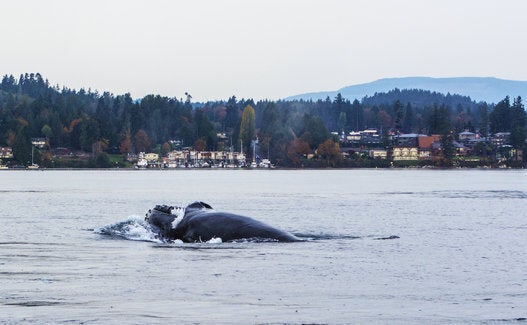When you are a multi-billion dollar, foreign-owned industry continuously mired in controversy over your environmental record, you have but two options: you clean up your act, or you clean up your image. The latest public relations offensive from B.C. salmon farmers leaves little doubt that for them, image is everything.
The problems with open-pen salmon farming are numerous and well-documented. Their issues with sea lice, the spread of disease to wild salmon, antibiotic and pesticide overuse and impacts upon other marine life (to name just a few) endure, despite decades of industry reassurances to the contrary.
Public resistance to salmon farms has also remained steadfast in B.C. One needs to look no further than last week's Global Climate March in Vancouver, where a veritable sea of homemade signs featuring sockeye salmon and anti-fish farm messages swam above the crowd of thousands. While marches in the rest of the world largely targeted the fossil fuel industry, in B.C., salmon farming is viewed as our own version of the tar sands, as despised as big oil.

Photo by Sabra Woodworth
The similarities aren't just in public perception. The salmon farming industry is increasingly using the same tactics as the fossil fuel industry to attempt to hide the reality of their environmental and social impact.
So when they are not silencing teenage girls from voicing concerns about their dirty business, salmon farmers are publishing self-congratulating paid advertorials (marketing masked as journalism) that paint a comically flattering portrait of the industry.
In one, they actually celebrate that less than three per cent of B.C. salmon farms have managed to meet their own, industry-defined standards for sustainability. Three per cent. A more truthful representation might be to say that more than 97 per cent do not meet their own goals for sustainability.
But it hardly matters. Such certification schemes are rarely effective -- they are designed by industry, with standards set by industry, for the benefit of industry. In fact, the latest certification program B.C. salmon farmers are touting actually removed the word 'sustainability' from its claims after realizing there was no workable intersection between sustainability and salmon farming.
And B.C. salmon farmers have a longer way to go towards sustainability than most. The B.C. industry was recently singled out as the second highest user of antibiotics in the world, behind only Chile, whose fish were recently removed from Costco stores because of high antibiotic use.
One wonders where B.C. salmon farmers rank in terms of pesticide use, given their inability to control their sea lice problem. Sea lice are well known to rapidly develop resistance to pesticides including the B.C. industry's stand-by treatment, SLICE. The DFO's recent approval of an alternate treatment against the pests, hydrogen peroxide baths, should raise concerns that SLICE use has also increased to world-leading levels.
Even less transparent than their claims of sustainability are the best-case estimates of the economic impact of salmon farming in B.C. that the salmon farmers try to sell us. Their estimates, of course, do not factor in the $50 million in government subsidies the industry received last year as payment for dead fish when disease outbreaks occur.
Nor do they factor in that, economically, wild salmon contribute eight times that of farmed salmon and create higher paying jobs than salmon farming -- a vibrant and local wild salmon economy that their feedlots put at risk. But it is not just salmon at risk.
We hear less often about the impacts of salmon farms on other fisheries, but the impacts are undoubtedly real, and serious. For instance, new reports out of Norway indicate that hydrogen peroxide use on salmon farms may be destroying shrimp populations. Is it simply a coincidence then, that Grieg Seafood, the Norwegian-owned salmon farming giant, recently attempted (unsuccessfully) to pay off B.C. shrimp fishermen with compensation for loss of income for allowing their feedlot operations to expand?
What is clear is that salmon farmers have no shame when it comes to green-washing their public image. The last of their recent paid advertorials attempts to glorify their relationship with B.C.'s First Nations, which despite their claims, is anything but harmonious.
Take, for example, last fall's two week stand-off at a newly sited salmon farm in Ahousaht First Nation territory, where Japanese-owned Cermaq was forced to remove the farm over concerns about its impact on wild salmon and traditional clam beds. And it is not just the Ahousaht for whom salmon farms are contentious.
The First Nations Wild Salmon Alliance, representing over a dozen nations, has clearly voiced its concerns about the industry, even leading a request for a NAFTA review of the harm to wild salmon from salmon farms in B.C.
The FNWSA has also raised what may be the most critically overlooked issue in the salmon farming debate: while coastal First Nations may have influence over siting of salmon farms in their waters, inland First Nations, who have depended upon the return wild salmon for generations and who are harmed most by the loss of wild salmon, have no say whatsoever. Divide and conquer is a strategy we have seen big oil use against First Nations in the past.
Like their corporate cousins in big oil, the multinational salmon farming corporations operating in B.C. think that glossy PR campaigns and toothless certification schemes are a substitute for real, responsible action. But putting style over substance will not help B.C.'s already struggling wild salmon. It is doubtful that they will be able to survive the combined threats of climate change and disease from open-pen salmon feedlots.
We are already locked into two or more degrees of global temperature rise. Salmon farmers have had decades to clean up their act and have failed to do so.
It is time for them to go, to give our wild salmon a fighting chance.
ALSO ON HUFFPOST:
